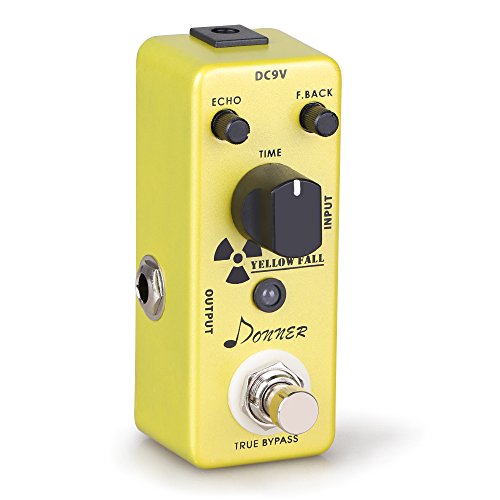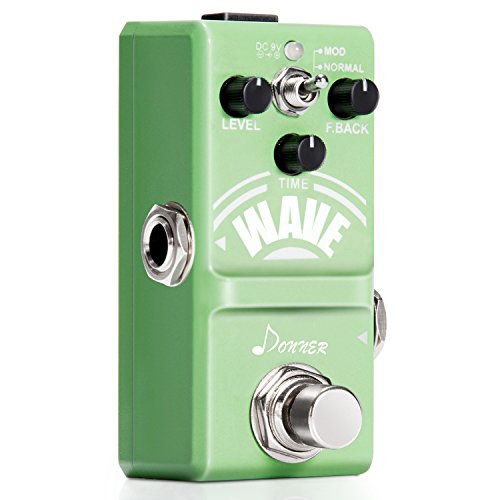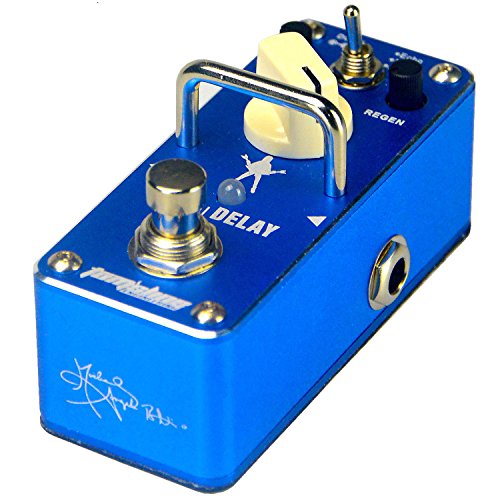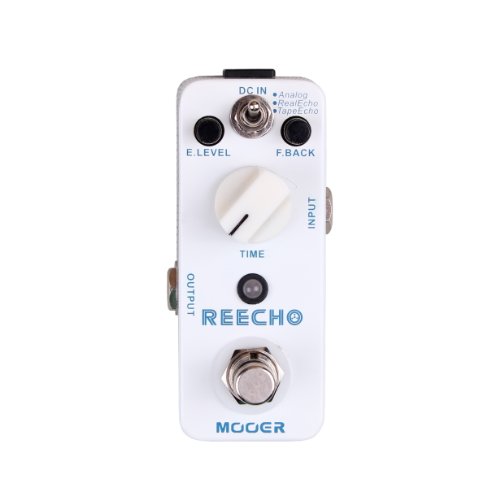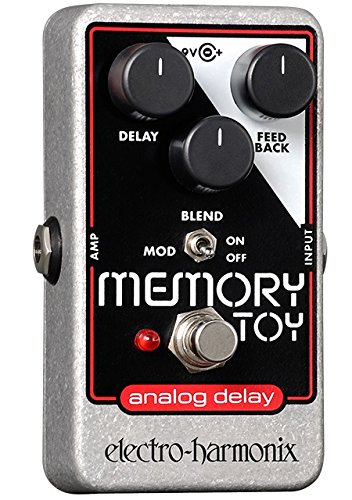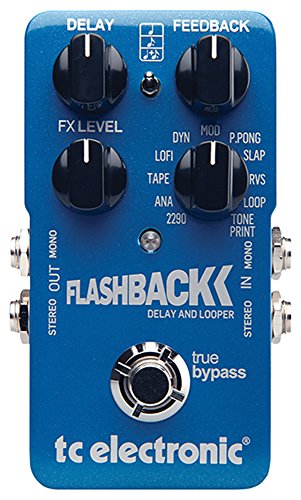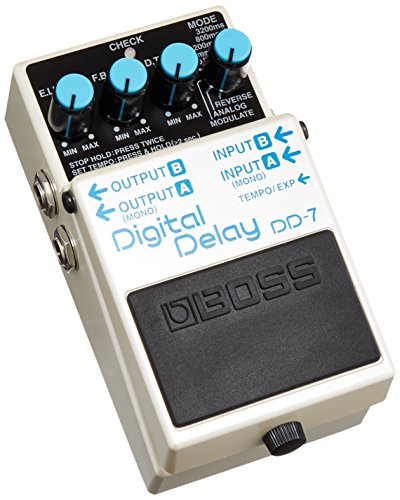Finding the best delay pedal isn’t such an easy task. After all, there are so many great options on the market, it can be hard to know where to start. Just picking the newest, most cutting-edge model isn't a good idea either. Models that have been around for years are still some of the best available. If you're looking for a classic pedal that's been around for some time, you may wish to read our review on the top Wah pedals.
What else do you need to consider?
You’ve got the question of analog or digital. You’ve got to choose how much you want to spend. And you need to know what kind of sound you want to create.
To make things easier for you, we’ve brought together some of the very best delay pedals that are currently available, including both analog delay pedals and digital delay pedals. These products will suit different styles, and, crucially, they're for sale at several different price points.
Hopefully, your next delay pedal is right here on this page! Looking for the Flange Effect? Click here for Flanger Pedals.
Are you looking for a versatile pedal to cover a huge range of effects? Check out our Multi-Effects Pedal review. Or better yet, if you're into bands such as Nirvana or the Police - and want to replicate their sound - see our review on Chorus Pedals (click here).
At a glance: Our top 3 picks
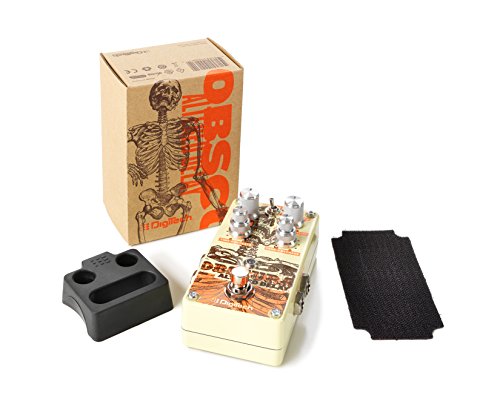
Digitech OBSCURA Altered Delay Pedal

- Four unique delay effects
- Stomplock
- Vacuum style footswitch
- 9V DC power supply
- Secure, high-density mount pad
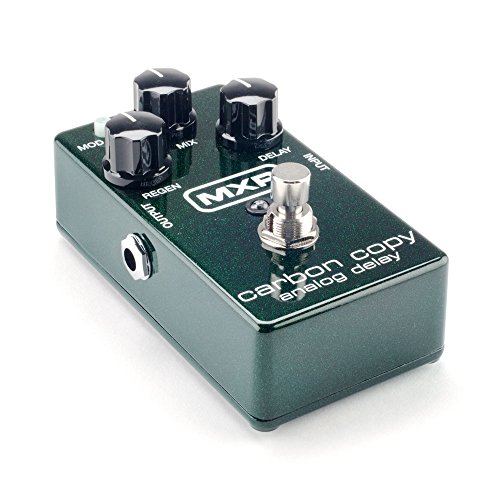
MXR M169 Carbon Copy Analog

- Four unique delay effects
- Stomplock
- Vacuum style footswitch
- 9V DC power supply
- Secure, high-density mount pad
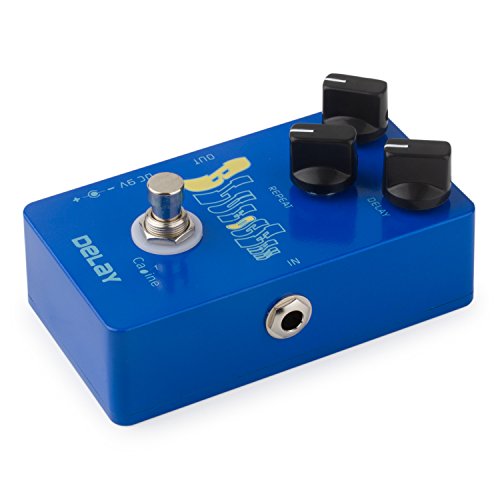
Caline Electric

- Four unique delay effects
- Stomplock
- Vacuum style footswitch
- 9V DC power supply
- Secure, high-density mount pad
Here is Our Review of the Top 10 Best Pedals for Delay in 2023 :
1. Digitech OBSCURA Altered Delay Pedal
The Digitech Obscura is one of the best delay pedals around. It’s loaded with lots of great features that allow you to take control of your sound and mess around with it, so that you get some very fun tones and effects. There are four different delay effects to choose from that are truly unique.
These effects are 'analog', 'lo-fi', 'tape', and 'reverse'. Delay tails can be easily toggled off and on with a flick of a switch. And there’s also a Stomplock, which means that your tone will be secure during live performances. No accidental knocks will change the settings when Stomplock is on.
Pros:
+ Four unique delay effects
+ Stomplock
+ Vacuum style footswitch
+ 9V DC power supply
+ Secure, high-density mount pad
Why We Liked It - A delay pedal should give you the power to alter your tone to create something unique. The variety in tone offered by this pedal – due to the four delay effects – makes it one of the best delay pedals on the market.
2. MXR M169 Carbon Copy Analog
No effects pedal list is complete without an MXR pedal making an appearance, and with that in mind, we’re pleased to include this MXR M169 Carbon Copy analog delay pedal on ours.
Whether you’re just after that slight ‘bathroom’ effect, or you’d like to draw out the delay effect for some progressive soundscapes, you can achieve it with the Carbon Copy’s regen, mix and delay dials. It doesn't quite reach digital levels, but the quality is impressive for an analog pedal. And, of course, being an analog pedal, then you get a nice, warm feel to the tone.
In terms of looks, then this pedal ticks all the boxes too. It's got a metallic, green finish that glitters in the light. MXR pedals are known for their unique style. And this one is no exception. It will look great as a part of any guitarist's pedalboard. Yes, it might not be the cheapest pedal on our list. But you get what you pay for, which is an excellent pedal that's built to last.
Pros:
+ Built like a tank
+ Warm sound
+ Plenty of customization options
Why We Liked It - The MXR Carbon Copy sits near the very top of the mid-price bracket, just before you get to the super expensive boutique pedals. But it is worth every penny, we think, especially if you need a delay pedal that will not let you down on stage or in the studio. Great tone, a good amount of delay effects available, and a superb chassis.
3. Caline Electric
It's possible that you've never heard of Caline pedals before. It's a new, Chinese brand that's aiming to offer excellent quality for an affordable price. The Blue Ocean delay pedal by Caline certainly ticks the boxes in this regard.
It is an extremely cheap delay pedal, which does a wonderful job of giving you a wide range of delay effects. If you just want a little bit of the warmth that classic analog delay adds, then it can do that. If you want something a bit more far out, it can do that too.
Of course, at this price, you have to expect to make some sacrifices, and with this unit, it’s the hardware quality that isn’t quite as good as the more expensive pedals. The chassis, switches, and jacks don’t feel super solid. There is a hint of hiss that gets added to the signal at louder volumes - click here for clean boost pedals. Although, it's important to note that the bypass function works perfectly.
Pros:
+ Ultra-cheap option
+ Level, delay, and repeat dials
+ Minimal coloration
Why We Liked It - It might have a couple of downsides, but at this price, they can be easily forgiven. This is a pedal that does the job without any frills. If you’re looking for something that you can use at home to play around with and have a bit of fun with, then it's ideal. It would probably do perfectly well for the odd live performance too.
4. Donner Delay
Another low-cost offering is the Yellow Fall by Donner. Immediately this pedal strikes you as looking completely different to Caline’s offering. It's bright yellow, with a nuclear warning symbol in the middle. It's also smaller than the previous pedal, featuring a mini chassis.
Again, it does exactly what you need it to do, and surprisingly, it doesn’t make too much difference to the tone - it’s great at being transparent, which is ideal if you’re looking for a pedal that sticks to the delay. The downside to this low-cost pedal is that the dials aren’t exactly linear in their adjustment, so it can be tricky to get it to be right where you want it. The miniature feedback and echo dials are also very small, making it hard to adjust on the fly.
The build quality is good despite this being a small pedal. We don’t see why you wouldn’t be able to use it live on tour. Donner - while not a hugely well-known brand - has a good reputation for offering functional and affordable pieces of hardware.
Pros:
+ Eye-catching looks
+ Transparent tone
+ Good build quality
Why We Liked It - We’ve decided to include Donner’s Yellow Fall in this list because it’s extremely cheap, and does a very good job of being a basic delay pedal. There are a few minor issues - such as those mentioned with the dials - but they don’t get in the way of this being a nice little pedal one you've become accustomed to it. If you're on a budget, it's a superb choice.
5. Donner Wave Analog
This is another great Donner pedal. It’s not quite as in-your-face as the last one in terms of appearance. Despite being slightly larger than the Yellow Fall, it is still a tiny pedal. The Wave is a quality analog delay pedal that's available at a very, very low price, and it's ideal for that much-desired, natural analog sound.
It offers level adjustment for the input signal, a time dial to adjust the gap between note and delay, and a feedback dial that allows you to adjust how many times you get the delay. There’s also a little switch that can be used to change the pedal from normal to modulated, which is a nice addition that you don’t see on many budget pedals.
This is also a surprisingly cool looking pedal. It comes in a sea-green color, which has a real 50s/60s beach rock vibe to it. As with the Yellow Fall, it’s extremely well-made. The only minor criticism is that the knobs are quite small.
Pros:
+ Awesome looks
+ Good range of delay sounds
+ Fantastic quality
Why We Liked It - It's a fantastic little pedal that's available for a very low price. You can get some cool oscillating delay out of it, and it looks like it could be a boutique unit ten times the price. The tiny size means that the knobs are small and there’s no space for a battery, but these are fairly minor disadvantages of a budget pedal that’s flawless in most other respects.
6. Tom'sline Digital Signature
Signature pedals can often be more of a vanity project than anything else, which is why they rarely make it onto lists like this one. However, this Tom’sline pedal is a bit different. It has been designed in conjunction with quad-necked guitar wielding legend Michael Angelo Batio, and we think that it's awesome. It’s also produced by budget brand Aroma, so it's available for an extremely attractive price.
MAB has been one of the most admired virtuoso guitarists, ever since his time in the 80s hair metal band Nitro, and this is his delay pedal of choice. If this interests you, and suits your style of playing, you may also be interested in Noise Gate Pedals - click here for a guide. As you might expect, an analog pedal wouldn’t give the range of versatility that MAB needs, so this is a digital unit. You can create a huge range of effects while using it, and the only feature it lacks is the warmth that an analog pedal delivers.
We have no concerns in regards to the construction. It's a highly robust unit. We also like the stop bar that wraps over the top and protects switches from being knocked when you hit the footswitch. It's a solid pedal for live performances.
Pros:
+ Michael Angelo Batio signature model
+ Massive delay customization
+ Excellent construction quality
Why We Liked It - This pedal is simply awesome. It looks great. It’s endorsed by Michael Angelo Batio. It sounds good. And it has a massive amount of customization options. It might lack the warmth of an analog pedal, but that's not what this pedal is about. It's a great choice for budding MABs who want versatility above all else.
7. Mooer Reecho Digital
The Mooer Reecho is a digital pedal, which has three different presets, one of which is ‘analog’, which replicates the warm feel you get from an analog delay pedal. It’s an effective effect. This pedal also offers ‘RealEcho’ and ‘TapeEcho’ effects too.
Let’s be clear - it’s not going to please a discerning audiophile. You can tell that this isn’t a real analog pedal, but the tradeoff is that you’re getting much more flexibility. This is especially good since this is priced firmly in the mid-range category. It’s certainly not going to break the bank.
You can get some great delay sounds out of this unit. There’s a lot to experiment with, and you get precise control over the effects you’re adding to your tone. It makes it very easy to find just the sound you’re looking for.
And finally, pedals don’t get a lot more stylish than this one.
Pros:
+ Beautiful finishing
+ Hugely versatile
+ Easy adjustment.
Why We Liked It - You get so much control over your sound with Reecho that it just had to go on our list. While the analog effect isn’t perfect, it’s a very useful addition indeed. What’s more is that this is a really well finished and well priced delay pedal. It has to be on your shortlist.
8. JOYO D-SEED Dual Channel
Possibly the biggest and most versatile pedal on our list, the Joyo D-Seed is a dual channel, digital delay pedal that ticks all the important boxes. It’s a proper, full-on digital effects unit that you can use for a live gig or in the studio. Surprisingly, this versatile pedal doesn’t cost much at all.
You get 'mix', 'mode', 'time', and 'feedback' pedals to fine-tune the perfect amount of delay that you’re looking for. Then, some footswitches will let you choose which of the two presets you’ve saved for your output. This is useful if you’ve got a standard delay sound for the majority of your songs, and you then want something a bit more out there as a backup.
It's worth noting that it does a good job of being transparent too.
It’s not a fancy looking unit. It’s all about functionality. But it’s finished very well, and it comes across as a professional choice. The cluster of knobs and switches might be a little complex for someone new to delay pedals, but it’s also quite easy to get to grips with.
Pros:
+ Incredibly versatile
+ Useful dual channel functionality
+ Hard-wearing construction
Why We Liked It - If you want the most versatile pedal on our list, then this one might just be it. For a low price, you’re getting a versatile digital effects pedal that has been designed for people who want full control over their delay effect. It's great for beginners and experienced pros alike.
9. Electro-Harmonix Memory Toy Analog
Electro-Harmonix is another brand that you can always expect to have an entry in any top delay pedal list. This Memory Toy nano delay pedal is the one we’ve picked, and it is just a great little unit.
Let’s begin with the options. There are delay, feedback, and blend dials, and then the fun modulation switch (which does add a little bit of gain). It feels like you’re getting a lot to play with, but if we’re honest, there isn’t a massive range of sounds.
That doesn’t matter though, because the depth and quality of the sound that this tiny analog pedal gives are very nice indeed. There are very few pedals that will give you delay that sounds this good. It’s hard to describe, but it just feels ever so slightly raw while remaining polished at the same time.
Finally, the chassis is very robust, is made in the USA, and we like the artistic, stylish design. A top-quality pedal.
Pros:
+ Awesome quality delay
+ High-quality hardware
+ Made in the USA
Why We Liked It - If you’re looking for something in the mid-range, and your priority is quality of sound rather than versatility, then we’d have to suggest the Memory Toy. It works very well with both electric guitars and electro-acoustics. It is highly recommended by our team.
10. TC Electronic FlashBack
The penultimate pedal on our list is loaded with lots of fantastic features. It is simply one of the best delay pedals out there, and is based on one of TC’s famous models - the 2290.
It’s supremely versatile, with more knobs than you’d know what to do with at first glance. There are no less than eleven different types of delay that you can select, along with a knob that controls the level of the particular effect you’ve chosen. There’s also standard delay and feedback controls too. If you need something that ranks among the best in any price range, then this is it.
It’s a nice looking pedal too, thanks to a high-quality, metallic blue finish. Everything feels sturdy and well-constructed, which is why you’ll find a lot of professional musicians using TC Electronic gear.
Pros:
+ Amazing versatility
+ Sturdy and well-constructed
+ High-quality hardware
Why We Liked It - If the FlashBack is in your price range, then it should be your top choice, unless, of course, you’re dead set on analog. There’s so much to play with. The best way we can describe this little thing is that it’s just plain fun. But that’s not to say it can’t be a serious touring pedal if you want it to be.
11. Boss DD-7
Year in, year out, the Boss DD-7 - much like many of Boss's other pedals - works its way onto the lists of the very best delay pedals. Which is one of the reasons that it’s on our list.
If you don’t mind the price tag, then there isn’t a more obvious digital choice on the market. You can create virtually any kind of delay sound that you want with it. It even does a very good job of emulating the warm sound of an analog too. It’s almost the perfect pedal, which is why so many guitarists swear by it. It delivers so many options. It's so easy to use. And, above all else, it's a great looking unit too.
And of course, we can't fail to mention Boss’s reputation for making their pedals feel like military-grade equipment. The footswitch is perfect proof of that hard-wearing, sturdy quality. This is undoubtedly a pedal that's designed for professional musicians, which is why many famous guitarists use it.
Pros:
+ Complete digital delay pedal
+ Amazingly high quality
+ Good analog imitation
Why We Liked It - It’s impossible to deny that the DD-7 is one of the most highly rated delay pedals on the market. It’ll do pretty much whatever you want, and it will provide you with years of use too. Its only real downside is its price. But it's worth it if you want profesional level quality.
Delay Pedal Buyers Guide
What is a Delay Pedal?
A delay pedal is one of the most commonly used effects pedals, along with distortion or overdrive pedals. It is used by almost every professional guitarist at some point in their career. The purpose is fairly simple. It takes the signal from the guitar, and then repeats it, almost like an echo.
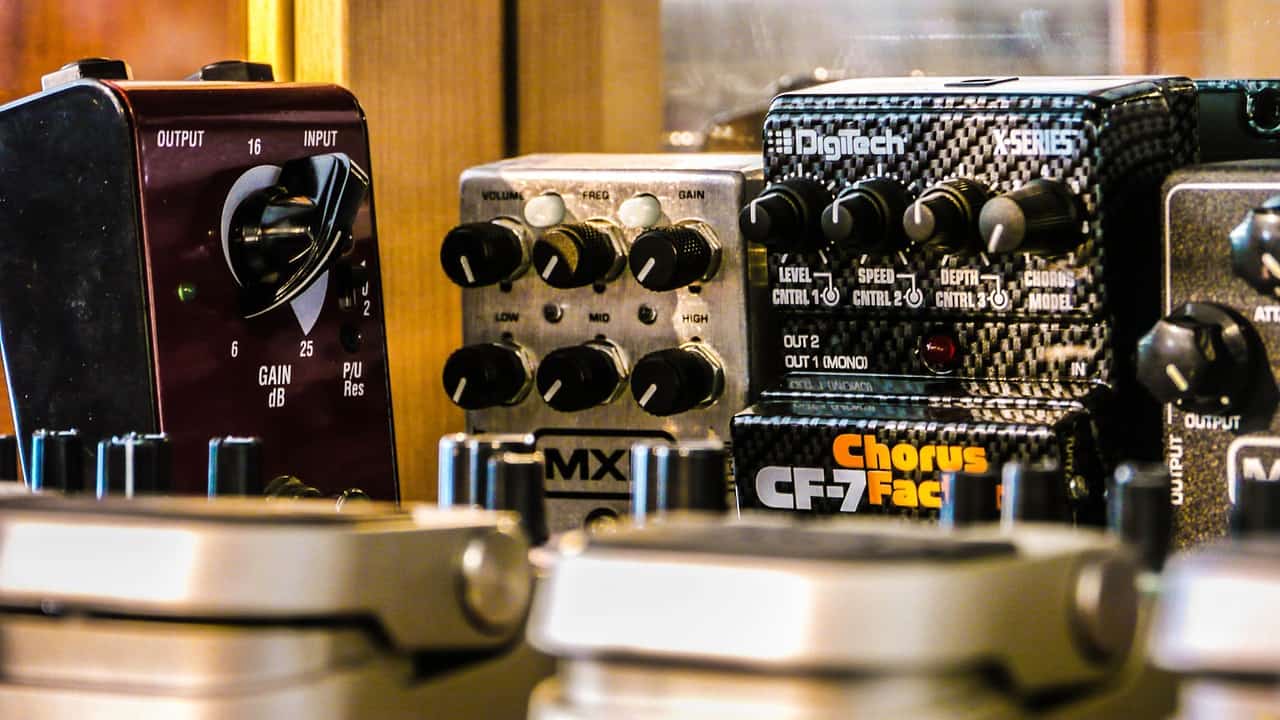 Most delay pedals are the same as other effects pedals in that they are a fairly simple box that sits somewhere between your guitar and amplifier or studio input. You choose the settings on the box, hit the footswitch, and then the effect is produced.
Most delay pedals are the same as other effects pedals in that they are a fairly simple box that sits somewhere between your guitar and amplifier or studio input. You choose the settings on the box, hit the footswitch, and then the effect is produced.
There are lots of different types of delay pedals, and there are different ways in which the delay effect is produced, which we’ll look at in the next sections.
What does a Delay Pedal do?
In terms of the sound produced, a delay pedal can do a lot of different things.
While you might think that adding a repeated signal would only be useful for specific types of songs, or certain bits of a song, the delay effect is in fact used much more often than you'd imagine. This is because a relatively quiet delay used a short time after the actual note is played will give the sound more depth. You might not even realize that a delay effect has been applied. This is why most guitarists will have a delay pedal. It isn't just for showy special effects.
Of course, there’s a whole host of other sounds that can be created with a delay pedal. You can make a faint echo for an eerie feel. You can stretch the delay out for a progressive soundscape. You can have a short, tight delay to get a ‘bathroom’ sound. And you can have a perfectly timed, rapid delay that will sound like you’re playing more notes than you are.
Analog vs Digital Delay Pedal
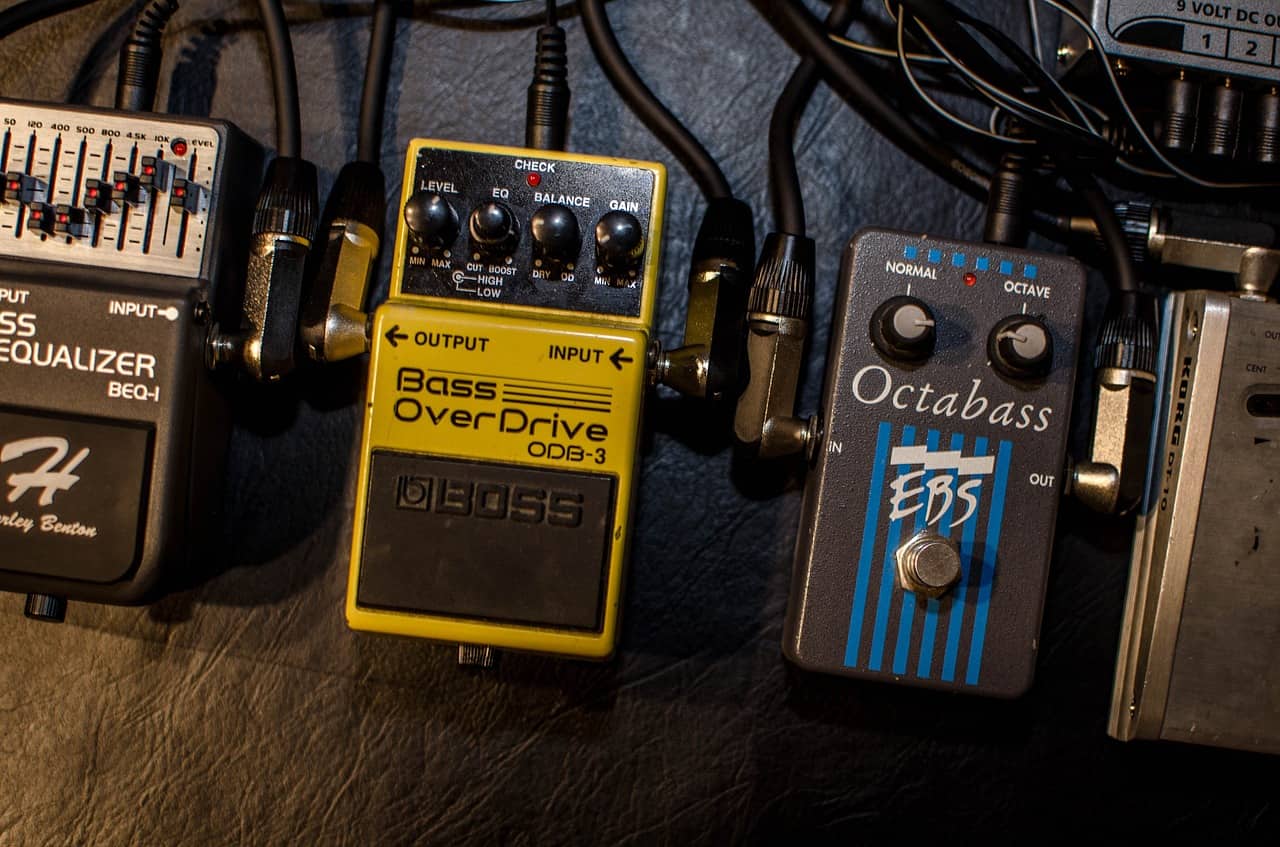 When browsing pedals, you’ve probably seen that a lot of product descriptions mention whether they’re an analog or digital pedal. So you’d be right in thinking that this is an important feature.
When browsing pedals, you’ve probably seen that a lot of product descriptions mention whether they’re an analog or digital pedal. So you’d be right in thinking that this is an important feature.
Let’s briefly take a look at what the two different terms mean, and how you can pick between these two different types of pedals.
An analog pedal will run the signal through a variety of pieces of hardware to achieve the delay effect. The signal generally passes through a series of capacitors. A chip will decide how all of this is done due to how you’ve set the dials that control the timing and amount of delay.
The key is that the signal that is outputted is still the same signal that came out of your guitar’s pickup. This signal is simply being altered. This also slightly alters the tone of the input as the signal is slightly diffused as it gets repeatedly put through the effect pedal. Lots of people would describe this tone as being warm.
A digital pedal, on the other hand, works quite differently. The analog, electrical signal that comes through the chain to the delay is converted into a digital one. This means that the digital processing unit in the pedal can do whatever it likes with the sound it receives.
So why is there a debate about which one to choose?
A digital pedal by its very nature is much more flexible than an analog one. An analog pedal has physical limitations, such as how long it can sustain the delay and other special kinds of delay effects that it can implement.
However, because digital pedals convert from an analog to a digital signal, lots of guitarists feel that some of the natural warmth is lost from their tone, in a similar way to some peoples’ preferences for vinyl rather than digital music.
Ultimately, the decision is up to you. If possible, you should experiment with both pedal types to see which one suits your style best.
How to use a Delay Pedal?
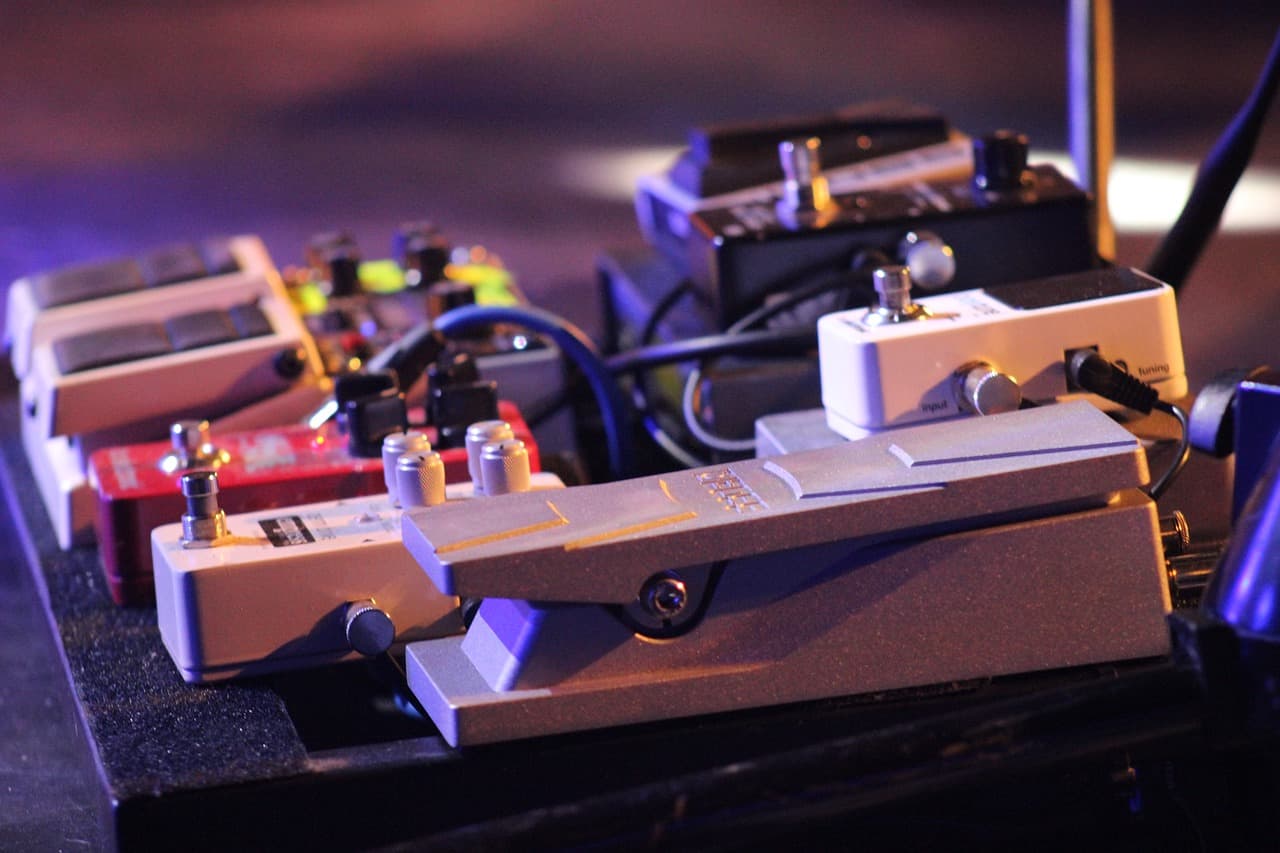 Delay pedals are straightforward to use, but they do take a little bit of tweaking to get them sounding as you want.
Delay pedals are straightforward to use, but they do take a little bit of tweaking to get them sounding as you want.
Let’s go through a few tips on how to get the most out of yours here.
The first point to note is that delay pedals are usually the last, or nearly the last, pedal in the effects chain. This is because you want to delay the signal for the sound and tone that you've created with your other effects pedals. Placing further effects such as distortion on a delayed signal often sounds messy, muddy, and undesirable.
So when you’re first using a delay pedal, make it is the last pedal on the chain before entering the amp.
On most delay pedals you’ll have dials that do three things. It’s these three dials that you need to know about because they will allow you to create the sound you want. It’s worth noting that they’re often labeled differently on different pedals, but it’s not usually too difficult to work out which is which.
The time dial will change the amount of time between the repetition of the signals. Digital pedals will have much larger potential intervals, but a short interval on an analog can help create a nice deep sound.
The feedback dial will alter the number of times that the signal is repeated, starting with just a single one. On some pedals, the maximum might be an infinite number of repeats.
The level dial - the last of three knobs - changes how loud each subsequent signal is. Cranked up to the max, then the repeated signal will be as loud as when you first struck the note.
There will likely be other switches on the pedal that will allow you to do other things, such as add a modulation effect or reverb (click here for pedals).
Once you’ve figured out the basics of your pedal, you can start to experiment, and explore a whole range of sounds.
Top Choice - Deadbeat DELAY LAY LAY Analog
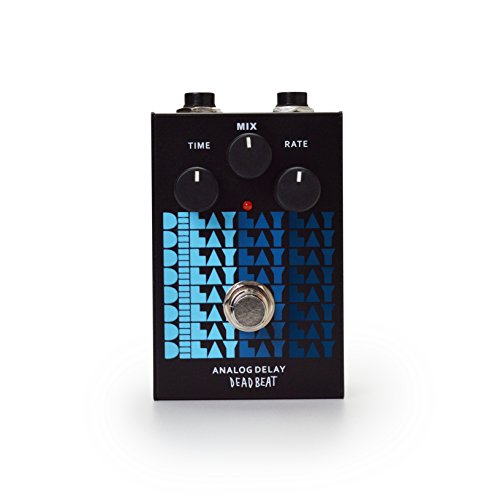 This pedal doesn't just have the best name. It's also the best delay pedal on the market, in our opinion, which is why it's our 'Top Choice'. It’s an analog pedal, which might divide opinion as some guitarists only use digital pedals. But we think it does a great job at being versatile, feeling well-built, and ultimately giving you the best tone.
This pedal doesn't just have the best name. It's also the best delay pedal on the market, in our opinion, which is why it's our 'Top Choice'. It’s an analog pedal, which might divide opinion as some guitarists only use digital pedals. But we think it does a great job at being versatile, feeling well-built, and ultimately giving you the best tone.
Regardless of the setting, the Delay Lay Lay exudes quality to the level that it would be perfect for recording as well as being used live. It’s that good. Sure, it’s not going to give you quite the versatility of a digital pedal, but you turn it on and you know that it’s a high-quality, old-school analog pedal that delivers gorgeous tone.
We have to admit that the Delay Lay Lay’s superb packaging and presentation helped it hit our top spot too. From the moment you open the box it looks and feels cool, which helps to make you feel like you’ve made a wise investment. Well done Deadbeat. What an awesome pedal!
Premium Choice - MXR M169 Carbon Copy Analog
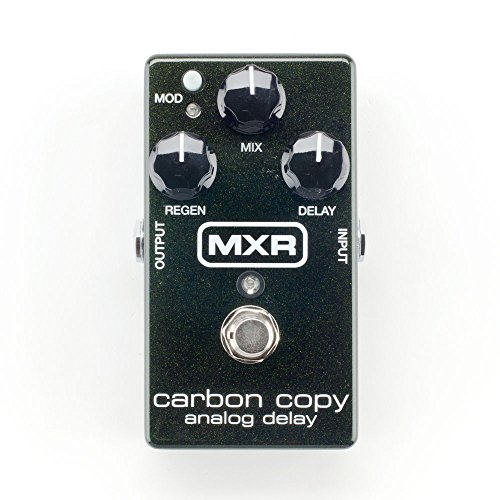 We were torn between the MXR Carbon Copy and the Boss DD-7 when it came to choosing our 'Premium Choice'. It wasn’t easy deciding between the two of them given that they’re similarly priced and are very different units, but in the end, we’ve gone for the analog Carbon Copy.
We were torn between the MXR Carbon Copy and the Boss DD-7 when it came to choosing our 'Premium Choice'. It wasn’t easy deciding between the two of them given that they’re similarly priced and are very different units, but in the end, we’ve gone for the analog Carbon Copy.
Why? We think it just has so much character to it. The sounds that it produced are unbeatable, and while it might not be as versatile as the DD-7, the Carbon Copy feels a bit more special. That’s not to say it’s limited. The knobs provide plenty of customization for the vast majority of sounds you might want to create.
The chassis is one of the best of all the pedals on our list. It looks gorgeous, thanks to the green metallic paint. But what stands out is the overwhelming sense of quality that the pedal exudes. The knobs and switches are tactile and robust. You get the feeling that this is a pedal that will last you decades.
Great Value - Caline Electric - B01LEZW304
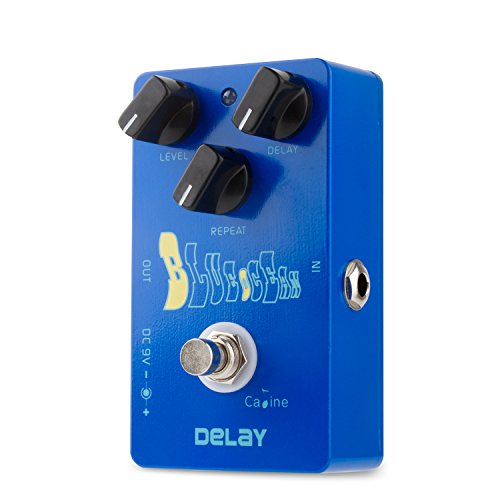 Our 'Great Value' pick is a true bypass, analog pedal. You could buy half a dozen of these pedals for the same price as the Carbon Copy. The Caline Blue Ocean is ridiculously cheap, and it should be the first pedal that you consider if you’re on a tight budget or aren’t sure if a delay pedal is right for you.
Our 'Great Value' pick is a true bypass, analog pedal. You could buy half a dozen of these pedals for the same price as the Carbon Copy. The Caline Blue Ocean is ridiculously cheap, and it should be the first pedal that you consider if you’re on a tight budget or aren’t sure if a delay pedal is right for you.
The Blue Ocean sounds good. It has that nice analog sound that you’d hope for. It does an impressive job of keeping your tone pretty much the same throughout. The bypass works perfectly too, and all of the knobs adjust linearly, making it easy to use.
Sure, the build quality isn’t the highest, but realistically, you’re not buying something at this price to take on tour with you. For jamming at home, this thing is perfect. There is a lot of budget options out there, but none are quite as good as this one.
Conclusion
So whatever your budget is, and whatever type of pedal you’re looking for, we’re sure you'll find your ideal pedal on our list. They are eleven, excellent pedals that you can’t go wrong with, ranging from premium, digital (click for the study on digital effects processing) units, to old-school analog metal. Check each one out, and then add the finishing touches to your effects chain. Delay is not only for guitars. It is also used for pianos too - click here for the study.
Digital Audio Effects can become confusing to understand, but we were helped along with the help of this study here.
If you liked this review by Music Critic, please leave a positive rating:

